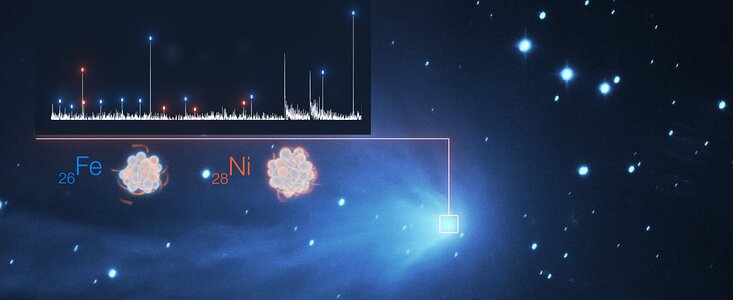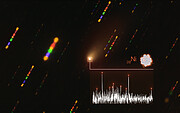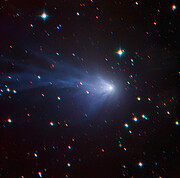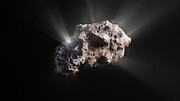Press Release
Heavy metal vapours unexpectedly found in comets throughout our Solar System — and beyond
19 May 2021
A new study by a Belgian team using data from the European Southern Observatory’s Very Large Telescope (ESO’s VLT) has shown that iron and nickel exist in the atmospheres of comets throughout our Solar System, even those far from the Sun. A separate study by a Polish team, who also used ESO data, reported that nickel vapour is also present in the icy interstellar comet 2I/Borisov. This is the first time heavy metals, usually associated with hot environments, have been found in the cold atmospheres of distant comets.
“It was a big surprise to detect iron and nickel atoms in the atmosphere of all the comets we have observed in the last two decades, about 20 of them, and even in ones far from the Sun in the cold space environment," says Jean Manfroid from the University of Liège, Belgium, who lead the new study on Solar System comets published today in Nature.
Astronomers know that heavy metals exist in comets’ dusty and rocky interiors. But, because solid metals don’t usually “sublimate” (become gaseous) at low temperatures, they did not expect to find them in the atmospheres of cold comets that travel far from the Sun. Nickel and iron vapours have now even been detected in comets observed at more than 480 million kilometres from the Sun, more than three times the Earth-Sun distance.
The Belgian team found iron and nickel in comets’ atmospheres in approximately equal amounts. Material in our Solar System, for example that found in the Sun and in meteorites, usually contains about ten times more iron than nickel. This new result therefore has implications for astronomers’ understanding of the early Solar System, though the team is still decoding what these are.
“Comets formed around 4.6 billion years ago, in the very young Solar System, and haven’t changed since that time. In that sense, they’re like fossils for astronomers,” says study co-author Emmanuel Jehin, also from the University of Liège.
While the Belgian team has been studying these “fossil” objects with ESO’s VLT for nearly 20 years, they had not spotted the presence of nickel and iron in their atmospheres until now. “This discovery went under the radar for many years,” Jehin says.
The team used data from the Ultraviolet and Visual Echelle Spectrograph (UVES) instrument on ESO’s VLT, which uses a technique called spectroscopy, to analyse the atmospheres of comets at different distances from the Sun. This technique allows astronomers to reveal the chemical makeup of cosmic objects: each chemical element leaves a unique signature — a set of lines — in the spectrum of the light from the objects.
The Belgian team had spotted weak, unidentified spectral lines in their UVES data and on closer inspection noticed that they were signalling the presence of neutral atoms of iron and nickel. A reason why the heavy elements were difficult to identify is that they exist in very small amounts: the team estimates that for each 100 kg of water in the comets’ atmospheres there is only 1 g of iron, and about the same amount of nickel.
“Usually there is 10 times more iron than nickel, and in those comet atmospheres we found about the same quantity for both elements. We came to the conclusion they might come from a special kind of material on the surface of the comet nucleus, sublimating at a rather low temperature and releasing iron and nickel in about the same proportions,” explains Damien Hutsemékers, also a member of the Belgian team from the University of Liège.
Although the team aren’t sure yet what material this might be, advances in astronomy — such as the Mid-infrared ELT Imager and Spectrograph (METIS) on ESO’s upcoming Extremely Large Telescope (ELT) — will allow researchers to confirm the source of the iron and nickel atoms found in the atmospheres of these comets.
The Belgian team hope their study will pave the way for future research. “Now people will search for those lines in their archival data from other telescopes,” Jehin says. “We think this will also trigger new work on the subject.”
Interstellar heavy metals
Another remarkable study published today in Nature shows that heavy metals are also present in the atmosphere of the interstellar comet 2I/Borisov. A team in Poland observed this object, the first alien comet to visit our Solar System, using the X-shooter spectrograph on ESO’s VLT when the comet flew by about a year and a half ago. They found that 2I/Borisov’s cold atmosphere contains gaseous nickel.
“At first we had a hard time believing that atomic nickel could really be present in 2I/Borisov that far from the Sun. It took numerous tests and checks before we could finally convince ourselves,” says study author Piotr Guzik from the Jagiellonian University in Poland. The finding is surprising because, before the two studies published today, gases with heavy metal atoms had only been observed in hot environments, such as in the atmospheres of ultra-hot exoplanets or evaporating comets that passed too close to the Sun. 2I/Borisov was observed when it was some 300 million kilometres away from the Sun, or about twice the Earth-Sun distance.
Studying interstellar bodies in detail is fundamental to science because they carry invaluable information about the alien planetary systems they originate from. “All of a sudden we understood that gaseous nickel is present in cometary atmospheres in other corners of the Galaxy,” says co-author Michał Drahus, also from the Jagiellonian University.
The Polish and Belgian studies show that 2I/Borisov and Solar System comets have even more in common than previously thought. “Now imagine that our Solar System's comets have their true analogues in other planetary systems — how cool is that?,” Drahus concludes.
More information
This research was presented in two papers to appear in Nature.
The team that carried out the study “Iron and nickel atoms in cometary atmospheres even far from the Sun“ (https://doi.org/10.1038/s41586-021-03435-0) is composed of J. Manfroid, D. Hutsemékers & E. Jehin (STAR Institute, University of Liège, Belgium).
The team that carried out the study “Gaseous atomic nickel in the coma of interstellar comet 2I/Borisov” (https://doi.org/10.1038/s41586-021-03485-4) is composed of Piotr Guzik and Michał Drahus (Astronomical Observatory, Jagiellonian University, Kraków, Poland).
ESO is the foremost intergovernmental astronomy organisation in Europe and the world’s most productive ground-based astronomical observatory by far. It has 16 Member States: Austria, Belgium, Czechia, Denmark, France, Finland, Germany, Ireland, Italy, the Netherlands, Poland, Portugal, Spain, Sweden, Switzerland and the United Kingdom, along with the host state of Chile and with Australia as a Strategic Partner. ESO carries out an ambitious programme focused on the design, construction and operation of powerful ground-based observing facilities enabling astronomers to make important scientific discoveries. ESO also plays a leading role in promoting and organising cooperation in astronomical research. ESO operates three unique world-class observing sites in Chile: La Silla, Paranal and Chajnantor. At Paranal, ESO operates the Very Large Telescope and its world-leading Very Large Telescope Interferometer as well as two survey telescopes, VISTA working in the infrared and the visible-light VLT Survey Telescope. Also at Paranal ESO will host and operate the Cherenkov Telescope Array South, the world’s largest and most sensitive gamma-ray observatory. ESO is also a major partner in two facilities on Chajnantor, APEX and ALMA, the largest astronomical project in existence. And on Cerro Armazones, close to Paranal, ESO is building the 39-metre Extremely Large Telescope, the ELT, which will become “the world’s biggest eye on the sky”.
Links
- Research papers:
- Photos of the VLT
- For journalists: subscribe to receive our releases under embargo in your language
- For scientists: got a story? Pitch your research
Contacts
Jean Manfroid
STAR Institute, University of Liège
Liège, Belgium
Tel: +32 4 366 97 25
Email: jmanfroid@gmail.com
Damien Hutsemékers
STAR Institute, University of Liège
Liège, Belgium
Email: D.Hutsemekers@uliege.be
Emmanuel Jehin
STAR Institute, University of Liège
Liège, Belgium
Tel: +32 470 850 172
Email: ejehin@uliege.be
Piotr Guzik
Astronomical Observatory, Jagiellonian University
Krakow, Poland
Tel: +48-126-238-627
Cell: +48-791-223-196
Email: piotr.guzik@doctoral.uj.edu.pl
Michał Drahus
Astronomical Observatory, Jagiellonian University
Krakow, Poland
Tel: +48-126-238-627
Cell: +48-578-221-628
Email: drahus@oa.uj.edu.pl
Bárbara Ferreira
ESO Media Manager
Garching bei München, Germany
Tel: +49 89 3200 6670
Cell: +49 151 241 664 00
Email: press@eso.org
About the Release
| Release No.: | eso2108 |
| Name: | 2I/Borisov, C/2016 R2 (PANSTARRS), Comet |
| Type: | Solar System : Interplanetary Body : Comet Milky Way : Interplanetary Body : Comet |
| Facility: | Very Large Telescope |
| Instruments: | UVES, X-shooter |
| Science data: | 2021Natur.593..375G 2021Natur.593..372M |








